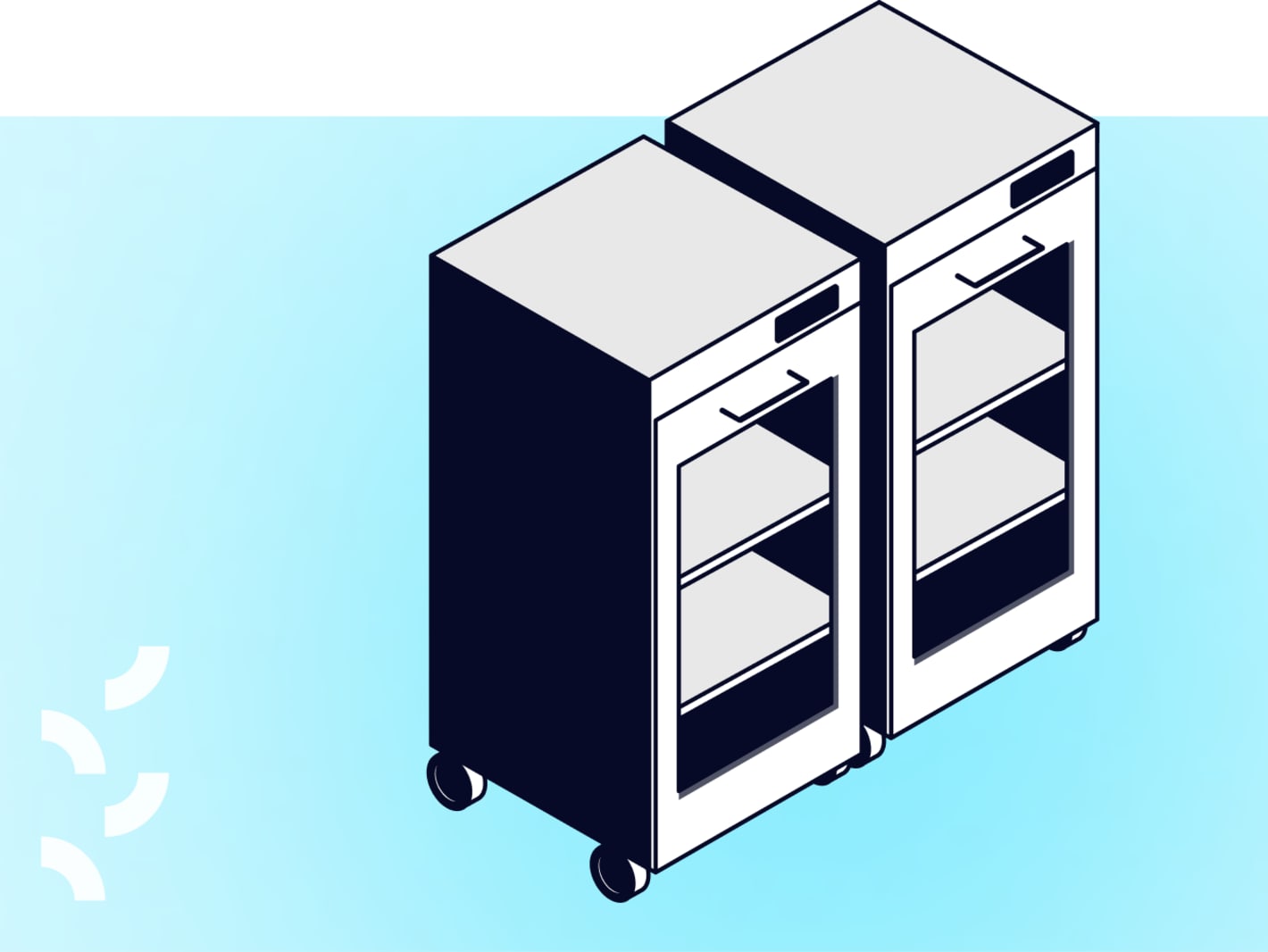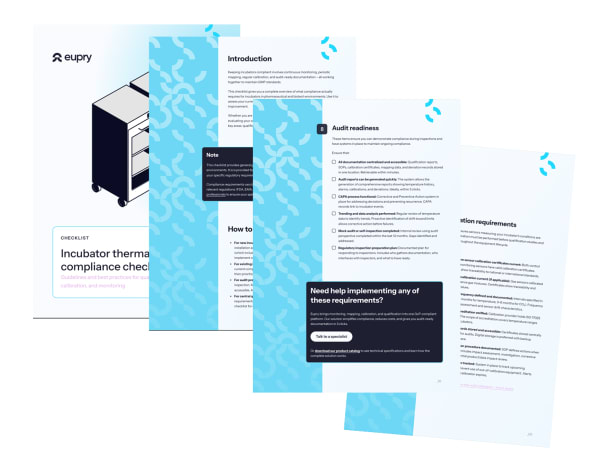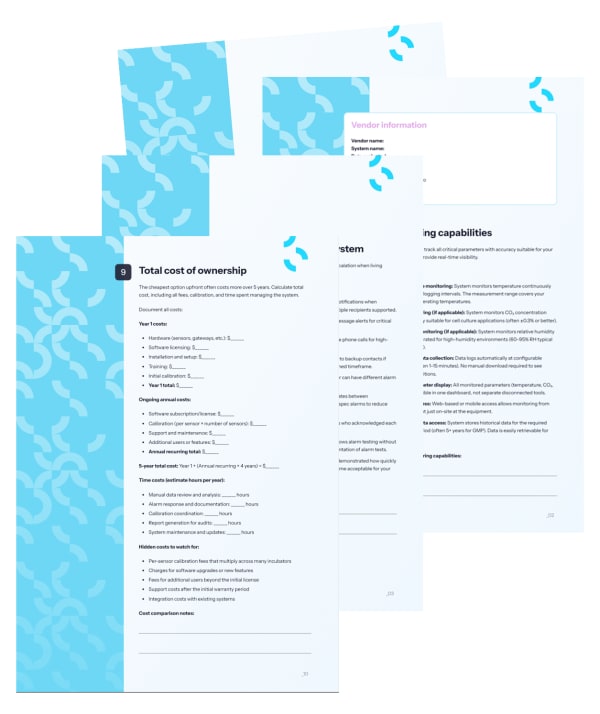How to handle thermal compliance for incubators
Guidelines for validation, mapping, and monitoring

Adam Hartmann-Kruckow
Pharmaceutical incubators hold materials that cannot tolerate temperature deviation: Microbiology samples, stability studies, cell cultures. One undetected excursion and you are looking at compromised batches, failed tests, or regulatory observations. This guide covers what GMP compliance actually requires for incubators – from daily monitoring to formal validation.
Guidelines for qualification, mapping, calibration, and monitoring for incubators used in GMP.
Table of contents
- What regulations cover incubator compliance in pharma?
- What are the thermal compliance requirements in GxP?
- How is validation of incubators performed?
- How to conduct temperature mapping of incubators?
- Download a thermal compliance checklist for incubators
- How to calibrate incubator sensors?
- How to conduct incubator monitoring?
- FAQ about incubator thermal compliance
Why incubators need GxP compliance
Incubators are controlled temperature chambers used for microbiology testing, stability studies, cell culture work, and other applications where temperature directly impacts results. They are classified as critical equipment under GMP because temperature deviations can cause product loss, invalid test results, or compromised samples.
What regulations are relevant for incubator compliance in pharma?
Regulatory expectations for thermal compliance of incubators cover elements such as:
- Annex 15 (qualification and validation): Equipment that impacts product quality must be qualified and maintained in a validated state. This means documented evidence that your incubator was installed correctly, operates within limits, and continues to perform over time.
- USP <1117> (microbiology lab practices): Labs using incubators for microbiology work must demonstrate equipment control, including documented monitoring, equipment validation and maintenance, alarm verification, and training on proper use. The chapter emphasizes that equipment must be operated and maintained according to manufacturer specifications and quality procedures.
- ISPE guidance (controlled temperature chambers): Risk-based qualification and lifecycle management apply to incubators just as they do to larger temperature-controlled units. You focus efforts on parameters that affect product or test integrity.
- FDA and EMA expectations: Inspectors commonly ask for incubator qualification records, temperature data, calibration certificates, and evidence of alarm testing. Missing or incomplete documentation flags risk.

What are the thermal compliance requirements in GxP?
The thermal compliance requirement covers four areas:
- validation and mapping (proof of uniformity)
- calibration (accuracy of measurement)
- monitoring (daily evidence of control)
Each supports the others.
What is validation for incubators?
Validation proves your incubator works correctly and will continue working correctly. This matters because regulators expect documented evidence that temperature-sensitive products stay within specification throughout their lifecycle.
How do you plan for incubator validation?
Before equipment arrives, establish the foundation:
- Risk assessment identifies critical parameters and potential failure modes. Which temperature ranges matter most? What happens if the door stays open too long? Where are the likely hot or cold spots?
- User Requirements Specification (URS) defines what the incubator must do for your operation. This typically includes temperature range, uniformity requirements, alarm functions, and documentation needs.
- Design Qualification (DQ) verifies the equipment design meets your URS and GxP requirements. For purchased equipment like incubators, DQ often means reviewing vendor documentation to confirm the unit can deliver what you need.
Also read: How to write a URS for pharmaceutical storage areas and TCUs?
The process has three phases: planning, initial qualification, and ongoing maintenance of the validated state.
What is initial qualification for incubators?
Initial qualification proves the incubator works as intended on day one. This happens through three connected studies:
- Installation Qualification (IQ): Verifies the incubator is installed according to specifications. This includes documenting equipment identification, utility connections, calibration status of sensors, installation environment, and review of manuals and certificates.
- Operational Qualification (OQ): Proves the incubator operates within specified limits. Testing often includes empty chamber mapping (learn more below), door open recovery tests, alarm function verification, and setpoint accuracy checks.
- Performance Qualification (PQ): Demonstrates consistent performance under actual use conditions. This involves loaded chamber testing with representative materials, extended monitoring periods (often 7+ days), and verification that temperature remains within acceptance criteria during routine operation.

How to conduct temperature mapping of incubators?
Temperature mapping is part of the qualification process and proves that conditions are uniform throughout the incubator chamber. It identifies hot spots, cold spots, and areas where temperature deviates from the setpoint.
What mapping studies measure
Mapping involves placing calibrated temperature loggers at multiple locations inside the chamber and recording data over a defined period (typically 24–72 hours). The study measures:
- Uniformity: The maximum temperature difference between any two points in the chamber. Acceptance criteria often specify that this difference must stay below 2°C or another limit based on your application.
- Stability: How much temperature fluctuates at each measurement point over time. You want tight control with minimal cycling.
- Recovery after disturbance: How quickly the incubator returns to setpoint after opening the door or adding new materials. This tests the system's ability to handle routine use.
Sensor placement principles
Logger placement follows a grid pattern that captures worst-case locations. For most incubators, this means:
- Four corners of the chamber
- Center of the chamber
- Near the door (coldest spot during door openings)
- Near the control probe
- Additional points for larger chambers
A 3×3 grid (9 sensors) works for smaller incubators. Larger units may need a 4×4 grid (16 sensors) or more based on chamber volume and risk assessment.
Empty vs loaded mapping
Empty chamber mapping (OQ): Tests the incubator's performance without product or materials inside. This isolates the equipment's capabilities from external variables.
Loaded mapping (PQ): Tests performance with representative materials in place to simulate actual use conditions. This shows how the incubator behaves when you're using it day to day.
Both are required for qualification. Empty mapping proves the equipment works. Loaded mapping proves it works under real-world conditions.
When to perform mapping studies
Initial qualification: When the incubator is first installed or relocated.
After significant changes: Major repairs, component replacement (heating elements, control boards), software updates, or physical modifications.
Periodic requalification: On a schedule based on risk (annually for high-risk applications, every 2–3 years for moderate risk).
Triggered by performance issues: If routine monitoring shows temperature trends approaching limits or if you observe inconsistent results in your work.
Continuous mapping as an alternative to periodic studies
Traditional mapping is a point-in-time snapshot. Continuous mapping uses permanent sensors and ongoing monitoring to maintain mapped evidence without periodic re-studies.
This approach provides continuous proof that uniformity and stability remain within acceptance criteria. Instead of requalifying every 1–3 years, you have ongoing data that shows the incubator still meets its original qualification standards.
Continuous mapping reduces disruption, lowers costs, and strengthens audit defenses by replacing episodic studies with permanent verification.
Also read: Continuous mapping explained – eliminate re-mappings with Eupry's continuous verification

Download a thermal compliance checklist for incubators
Get a free step-by-step overview of the guidelines and best practices for qualification, mapping, calibration, and monitoring for incubators used in GMP.
How to calibrate of incubator sensors
Frequency and methods
Calibration ensures that the sensors measuring your incubator's conditions are accurate. Without calibration, you don't know if a reading of 37°C actually represents 37°C or if the sensor has drifted.
What needs calibration
- Temperature sensors: Both the incubator's built-in control probe and any external monitoring sensors require regular calibration. These are typically calibrated against a reference standard traceable to national or international standards (ISO 17025 accreditation).
- CO₂ sensors: For incubators with CO₂ control, the gas sensor must be calibrated using reference gas mixtures. CO₂ sensors drift faster than temperature sensors, which makes frequent calibration critical.
Note: If you use separate sensors/data loggers used for mapping they should also have a valid calibration certificate. However, with some vendors (like Eupry), you can use the same data loggers for both mapping and monitoring.

Calibration frequency
Calibration intervals depend on sensor type, application risk, and manufacturer recommendations. Typical intervals for GxP is, for instance:
- Temperature sensors: Typically every 12 months for control probes, 12–24 months for monitoring sensors.
- CO₂ sensors: Often every 6–12 months (more frequently for critical applications), as CO₂ sensors drift faster than temperature sensors.
- Mapping sensors: Before and after each mapping study, or annually if used frequently.
Higher-risk applications justify more frequent calibration. Lower-risk applications can extend intervals if supported by trend data showing stable performance.
Traditional calibration challenges
Conventional calibration creates operational problems:
- Downtime: Removing sensors for calibration takes the incubator offline or leaves it unmonitored during calibration.
- Logistics: Shipping sensors to a calibration lab, waiting for turnaround, reinstalling sensors, and verifying operation takes time and coordination.
- Cost: External calibration services charge per sensor, and costs add up across multiple incubators and sites.
- Data gaps: While sensors are out for calibration, you either have no monitoring data or must install temporary backup sensors.
On-the-wall calibration
An alternative approach calibrates sensors in place without removal. New calibrated sensors replace the existing ones in seconds, and calibration data integrates automatically with the monitoring system.
This eliminates downtime, removes logistical complexity, and ensures continuous data coverage.

Get a incubator monitoring system evaluation checklist
Choosing the right monitoring system determines whether you catch problems before they cause damage or discover failures after samples are lost. This checklist helps you evaluate vendors based on the features that actually matter for incubator compliance in pharma.
How to handle incubator monitoring according to Annex 11 and 21 CFR Part 11?
Temperature and CO₂ data from incubators is GMP documentation that must meet electronic records requirements. If your data is not traceable, secure, and tamper-evident, it will not hold up during an inspection.
What regulators typically require
- EU Annex 11 (computerized systems): Applies to any software that captures, processes, or stores GMP data. This includes incubator monitoring systems, mapping software, and calibration databases.
- FDA 21 CFR Part 11 (electronic records and signatures): US equivalent covering the same ground – electronic records must be as reliable and trustworthy as paper records. Learn more about 21 CFR Part 11 for monitoring in pharma.
Both regulations require:
Audit trails: Every data point, alarm, configuration change, and user action must be logged with a timestamp and a user ID. You need to show who did what and when. The audit trail must be secure and cannot be disabled.
Access controls: Role-based permissions ensure only authorized users can view, edit, or export data. This prevents unauthorized changes and maintains accountability.
Electronic signatures: Critical actions (e.g., acknowledging alarms, approving deviation reports) require electronic signatures that are unique to each individual and linked to their identity through secure authentication.
Data security and backup: Data must be stored securely with encryption and continuous backups. Storage must align with ISO 27001 standards and Eudralex Vol. 4 Annex 11 requirements for data protection.
ALCOA+ principles: Data must be Attributable, Legible, Contemporaneous, Original, Accurate, complete, consistent, enduring, and available. This means no manual transcription, no data gaps, and no opportunity for manipulation.
Common data integrity risks
- Manual logging: Transcribing readings from incubator displays into spreadsheets creates transcription errors and opportunities for manipulation. Manual records are hard to verify and easy to alter.
- Non-validated systems: Using generic data logging software that wasn't designed for GMP creates compliance gaps. These systems often lack proper audit trails, access controls, or backup procedures.
- Paper records: While allowed, paper creates problems. It is hard to search, easy to lose, vulnerable to damage, and doesn't provide the real-time visibility that automated systems offer.
Moving to validated electronic systems eliminates these risks and makes compliance easier, not harder.
How to standardize procedures for incubator thermal compliance
Running qualification studies from scratch every time wastes time and introduces variability. Standardized templates and SOPs ensure consistency, reduce errors, and make audits easier.
Templates don't just save time. They reduce variability across sites, make training easier, and ensure you capture the documentation that auditors expect to see.
What you typically need
- Incubator monitoring SOP: Procedures covering alarm response, data review frequency, deviation handling, and escalation paths. This ensures everyone follows the same process.
- Temperature mapping SOP: Step-by-step instructions for logger placement (grid layout, specific positions), study duration, acceptance criteria for uniformity and stability, and corrective actions if results fall outside limits. Learn more about best practices for mapping.
- IQ/OQ/PQ protocol templates: Pre-built protocols you can adapt to specific incubator models and site requirements. Include test objectives, acceptance criteria, equipment lists, data collection tables, and approval signatures.
- Calibration procedure: Documents calibration frequency, acceptance criteria, and what to do if calibration fails. Links to your calibration provider's ISO 17025 accreditation and defines traceability requirements.
- Audit-ready report templates: Structured formats for presenting qualification results. Include executive summary, test methodology, raw data tables, trend charts, acceptance criteria comparison, deviations (if any), and conclusion statement.
Also see: Temperature mapping report template

Handle incubator thermal compliance in one platform with Eupry
You have seen what compliance requires: validation, continuous monitoring, periodic mapping, regular calibration, and data integrity throughout.
Most companies manage these with multiple vendors, disconnected systems, and manual coordination. That creates gaps.
Eupry brings everything into one GxP-compliant platform:
- Continuous monitoring with automated alerts: WiFi-enabled sensors track temperature and CO₂ in real time. Data flows automatically to a central dashboard visible across all sites. Set alarm thresholds based on your acceptance criteria, and get instant notifications when readings approach or exceed limits.
- Integrated mapping and continuous verification: Run initial mapping studies with digital test plans that can be created centrally and accessed from any location. Then maintain compliance through continuous mapping without periodic re-studies.
- On-the-wall calibration included: ISO 17025-accredited calibration happens directly at the sensor location. Replace existing sensors with newly calibrated ones in seconds. No downtime, no shipping logistics, no data gaps. Calibration certificates are automatically uploaded to the system.
In other words, not just monitoring software but a complete compliance infrastructure that connects monitoring, mapping, calibration, and qualification into one system.
